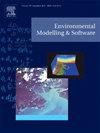基于贝叶斯混合的深度集成机器学习提高了稀疏监测地区地面臭氧模型的准确性和精度:澳大利亚,2005-2018
IF 4.8
2区 环境科学与生态学
Q1 COMPUTER SCIENCE, INTERDISCIPLINARY APPLICATIONS
引用次数: 0
摘要
地面臭氧(O3)是一个重大的公共卫生问题。我们绘制了澳大利亚新南威尔士州(2005-2018年)每月平均1小时最大臭氧浓度的地图,这是一个监测较少的地区。贝叶斯最大熵(BME)混合首次在深度集成机器学习(DEML)框架中用于空气污染预测。DEML将随机森林(RF)、极端梯度增强(XGBoost)和梯度增强机(GBM)模型中的地理预测因子与三个元模型结合起来。BME混合将观测到的O3数据纳入后验预测。我们生成了2.5 km × 2.5 km分辨率的网格曲面。DEML估计的R2为0.89,RMSE为2.3 ppb。BME混合改善了DEML网格细胞预测(R2: 0.84, RMSE: 3.03 ppb) (R2: 0.89, RMSE: 2.49 ppb)。平均偏置从−0.7 ppb降至−0.4 ppb。这表明在监测较少的地区具有很高的准确性和精密度。本文章由计算机程序翻译,如有差异,请以英文原文为准。

Deep ensemble machine learning with Bayesian blending improved accuracy and precision of modelled ground-level ozone for region with sparse monitoring: Australia, 2005–2018
Ground-level ozone (O3) is a significant public health concern. We developed maps of monthly average 1-h maximum O3 concentrations in New South Wales, Australia (2005–2018), a region with sparse monitoring. For the first time Bayesian Maximum Entropy (BME) blending was used within a Deep Ensemble Machine Learning (DEML) framework for air pollution predictions. The DEML combined geographical predictors in random forest (RF), extreme gradient boosting (XGBoost), and gradient boosted machine (GBM) models with three meta-models. BME blending incorporated observed O3 data into posterior predictions. We generated 2.5 km × 2.5 km resolution gridded surfaces. The DEML estimates achieved an R2 of 0.89 and RMSE of 2.3 ppb in the held-out test dataset at monitors. DEML grid cell predictions (R2: 0.84, RMSE: 3.03 ppb) were improved by BME blending (R2: 0.89, RMSE: 2.49 ppb). Mean bias reduced from −0.7 ppb to −0.4 ppb. This demonstrates high accuracy and precision in a sparsely monitored region.
求助全文
通过发布文献求助,成功后即可免费获取论文全文。
去求助
来源期刊

Environmental Modelling & Software
工程技术-工程:环境
CiteScore
9.30
自引率
8.20%
发文量
241
审稿时长
60 days
期刊介绍:
Environmental Modelling & Software publishes contributions, in the form of research articles, reviews and short communications, on recent advances in environmental modelling and/or software. The aim is to improve our capacity to represent, understand, predict or manage the behaviour of environmental systems at all practical scales, and to communicate those improvements to a wide scientific and professional audience.
 求助内容:
求助内容: 应助结果提醒方式:
应助结果提醒方式:


